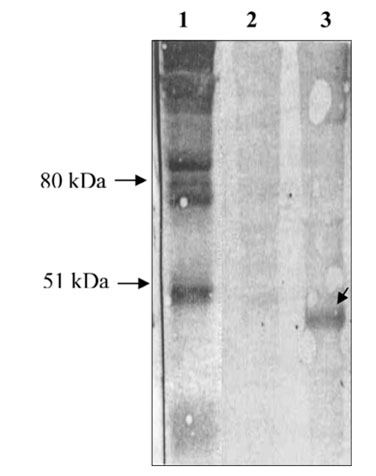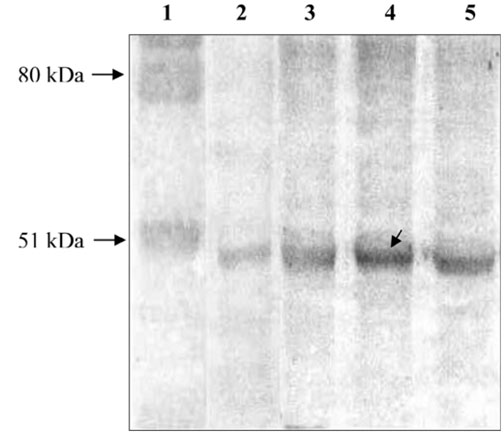J Vet Sci.
2006 Sep;7(3):241-247. 10.4142/jvs.2006.7.3.241.
Efficacy of VP2 protein expressed in E. coli for protection against highly virulent infectious bursal disease virus
- Affiliations
-
- 1Institute of Bioscience, University Putra Malaysia, 43400 UPM Serdang, Selangor Darul Ehsan, Malaysia. aro@ibs.upm.edu.my
- 2Faculty of Veterinary Medicine, University Putra Malaysia, 43400 UPM Serdang, Selangor Darul Ehsan, Malaysia.
- KMID: 1089908
- DOI: http://doi.org/10.4142/jvs.2006.7.3.241
Abstract
- The ability of a heat-inactivated whole virus from a highly virulent infectious bursal disease virus (hvIBDV) and VP2 protein from hvIBDV expressed in E. coli provided protection against a hvIBDV challenge in specificpathogen- free (SPF) chickens. Six out of seven chickens that were injected three times with crude VP2 protein developed significant antibody titer against IBDV. However, only four out of the seven chickens survived the hvIBDV challenge. Despite showing low antibody titer profiles, all chickens immunized with the heat-inactivated whole virus also survived the challenged with hvIBDV. However, all of these chickens had bursal atrophy and mild to moderate depletion of lymphocytes. Thus, antibodies raised against IBDV VP2 protein expressed in E. coli and denatured IBDV proteins induced some degree of protection against mortality but not against bursal damage following challenge with hvIBDV.
Keyword
MeSH Terms
-
Animals
Antibodies, Viral/blood
Birnaviridae Infections/immunology/prevention & control/*veterinary/virology
Chickens
Enzyme-Linked Immunosorbent Assay/veterinary
Escherichia coli/genetics
Immunization/standards/*veterinary
Infectious bursal disease virus/genetics/*immunology/pathogenicity
Poultry Diseases/*immunology/prevention&control/virology
Recombinant Proteins/genetics/*immunology
Specific Pathogen-Free Organisms
Vaccines, Attenuated/immunology/pharmacology
Vaccines, Synthetic/immunology/pharmacology
Viral Structural Proteins/biosynthesis/genetics/*immunology
Viral Vaccines/*immunology/pharmacology
Figure
Reference
-
1. Aucouturier J, Dupuis L, Ganne V. Adjuvants designed for veterinary and human vaccines. Vaccine. 2001. 19:2666–2672.
Article2. Azad AA, Fahey KJ, Barrett SA, Erny KM, Hudson PJ. Expression in Escherichia coli of cDNA fragments encoding the gene for the host-protective antigen of infectious bursal disease virus. Virology. 1986. 149:190–198.
Article3. Azad AA, McKern NM, Macreadie IG, Failla P, Heine HG, Chapman A, Ward CW, Fahey KJ. Physicochemical and immunological characterization of recombinant host-protective antigen (VP2) of infectious bursal disease virus. Vaccine. 1991. 9:715–722.
Article4. Bayliss CD, Peters RW, Cook JKA, Reece RL, Howes K, Binns MM, Boursnell MEG. A recombinant fowlpox virus that expresses the VP2 antigen of infectious bursal disease virus induces protection against mortality caused by the virus. Arch Virol. 1991. 120:193–205.
Article5. Bayliss CD, Spies U, Shaw K, Peters RW, Papageorgiou A, Muller H, Boursnell MGE. A comparison of the sequences of segment A of four infectious bursal disease virus strains and identification of a variable region in VP2. J Gen Virol. 1990. 71:1303–1312.
Article6. Cao YC, Shi QC, Ma JY, Xie QM, Bi YZ. Vaccination against very virulent infectious bursal disease virus using recombinant T4 bacteriophage displaying viral protein VP2. Acta Biochim Biophys Sin (Shanghai). 2005. 37:657–664.
Article7. Chong LK, Omar AR, Yusoff K, Hair-Bejo M, Aini I. Nucleotide sequence and phylogenetic analysis of a segment A of a highly virulent strain of infectious bursal disease virus. Acta Virol. 2001. 45:217–226.8. Darteil R, Bublot M, Laplace E, Bouquet JF, Audonnet JC, Riviere M. Herpesvirus of turkey recombinant viruses expressing infectious bursal disease virus (IBDV) VP2 immunogen induce protection against an IBDV virulent challenge in chickens. Virology. 1995. 211:481–490.
Article9. Fahey KJ, Erny K, Crooks J. A conformational immunogen on VP2 of infectious bursal disease virus that induces virus-neutralizing antibodies that passively protect chickens. J Gen Virol. 1989. 70:1473–1481.
Article10. Francois A, Chevalier C, Delmas B, Eterradossi N, Toquin D, Rivallan G, Langlois P. Avian adenovirus CELO recombinants expressing VP2 of infectious bursal disease virus induce protection against bursal disease in chickens. Vaccine. 2004. 22:2351–2360.
Article11. Giambrone JJ, Closser J. Efficacy of live vaccines against serologic subtypes of infectious bursal disease virus. Avian Dis. 1990. 34:7–11.
Article12. Hoque MM, Omar AR, Chong LK, Hair-Bejo M, Aini I. Pathogenicity of Ssp1-positive infectious bursal disease virus and molecular characterization of the VP2 hypervariable region. Avian Pathol. 2001. 30:369–380.
Article13. Hulse DJ, Romero CH. Partial protection against infectious bursal disease virus through DNA-mediated vaccination with the VP2 capsid protein and chicken IL-2 genes. Vaccine. 2004. 22:1249–1259.
Article14. Jagadish MN, Staton VJ, Hudson PJ, Azad AA. Birnavirus precursor polyprotein is processed in Escherichia coli by its own virus-encoded polypeptide. J Virol. 1988. 62:1084–1087.
Article15. Kim SJ, Sung HW, Han JH, Jackwood D, Kwon HM. Protection against very virulent infectious bursal disease virus in chickens immunized with DNA vaccines. Vet Microbiol. 2004. 101:39–51.
Article16. Krieg AM. CpG motifs in bacterial DNA and their immune effects. Annu Rev Immunol. 2002. 20:709–760.
Article17. Laemmli UK. Cleavage of structural proteins during assembly of the head of bacteriophage T4. Nature. 1970. 227:680–685.
Article18. Lasher HN, Shane SM. Infectious bursal disease. Worlds Poult Sci J. 1994. 50:133–166.
Article19. Li J, Huang Y, Liang X, Lu M, Li L, Yu L, Deng R. Plasmid DNA encoding antigens of infectious bursal disease viruses induce protective immune responses in chickens: factors influencing efficacy. Virus Res. 2003. 98:63–74.
Article20. Lukert PD, Saif YM. Calnek BW, Barnes JH, Beard CW, McDougald LR, Saif YM, editors. Infectious bursal disease of poultry. Diseases of Poultry. 1997. 10th ed. Ames: Iowa State University Press;721–738.21. Martinez-Torrecuadrada JL, Saubi N, Pages-Mante A, Caston JR, Espuna E, Casal JI. Structure-dependent efficacy of infectious bursal disease virus (IBDV) recombinant vaccines. Vaccine. 2003. 21:3342–3350.
Article22. Oppling V, Muller H, Becht H. Heterogeneity of the antigenic site responsible for the induction of neutralizing antibodies in infectious bursal disease virus. Arch Virol. 1991. 119:211–223.
Article23. Phenix KV, Wark K, Luke CJ, Skinner MA, Smyth JA, Mawhinney KA, Todd D. Recombinant Semliki Forest virus vector exhibits potential for avian virus vaccine development. Vaccine. 2001. 19:3116–3123.
Article24. Pitcovski J, Di-Castro D, Shaaltiel Y, Azriel A, Gutter B, Yarkoni E, Michael A, Krispel S, Levi BZ. Insect cell-derived VP2 of infectious bursal disease virus confers protection against the disease in chickens. Avian Dis. 1996. 40:753–761.
Article25. Pitcovski J, Gutter B, Gallili G, Goldway M, Perelman B, Gross G, Krispel S, Barbakov M, Michael A. Development and large-scale use of recombinant VP2 vaccine for the prevention of infectious bursal disease of chickens. Vaccine. 2003. 21:4736–4743.
Article26. Rautenschlein S, Kraemer CH, Vanmarcke J, Montiel E. Protective efficacy of intermediate and intermediate plus infectious bursal disease virus (IBDV) vaccines against very virulent IBDV in commercial broilers. Avian Dis. 2005. 49:231–237.
Article27. Rautenschlein S, Yeh HY, Sharma JM. The role of T cells in protection by an inactivated infectious bursal disease virus vaccine. Vet Immunol Immunopathol. 2002. 89:159–167.
Article28. Rong J, Cheng T, Liu X, Jiang T, Gu H, Zou G. Development of recombinant VP2 vaccine for the prevention of infectious bursal disease of chickens. Vaccine. 2005. 23:4844–4851.
Article29. Tsukamoto K, Sato T, Saito S, Tanimura N, Hamazaki N, Mase M, Yamaguchi S. Dual-viral vector approach induced strong and long-lasting protective immunity against very virulent infectious bursal disease virus. Virology. 2000. 269:257–267.
Article30. Vakharia VN, Snyder DB, Lutticken D, Mengel-Whereat SA, Savage PK, Edwards GH, Goodwin MA. Active and passive protection against variant and classic infectious bursal disease virus strains induced by baculovirus-expressed structural proteins. Vaccine. 1994. 12:452–456.
Article31. Berg TP, Meulemans G. Acute infectious bursal disease in poultry: protection afforded by maternally derived antibodies and interference with live vaccination. Avian Pathol. 1991. 20:409–421.
Article32. Wu H, Singh NK, Locy RD, Scissum-Gunn K, Giambrone JJ. Immunization of chickens with VP2 protein of infectious bursal disease virus expressed in Arabidopsis thaliana. Avian Dis. 2004. 48:663–668.
Article
- Full Text Links
- Actions
-
Cited
- CITED
-
- Close
- Share
- Similar articles
-
- Evaluation of modified vaccinia virus Ankara expressing VP2 protein of infectious bursal disease virus as an immunogen in chickens
- Detection of Antibodies to Infectious Bursal Disease Virus (IBDV) by Agar Gel Immunodiffusion using Recombinant VP2 Protein
- Sequence analysis of segment A gene of a very virulent infectious bursal disease virus recently isolated in Korea
- Molecular characterization of two Bangladeshi infectious bursal disease virus isolates using the hypervariable sequence of VP2 as a genetic marker
- Expression of the VP2 protein of feline panleukopenia virus in insect cells and use thereof in a hemagglutination inhibition assay



